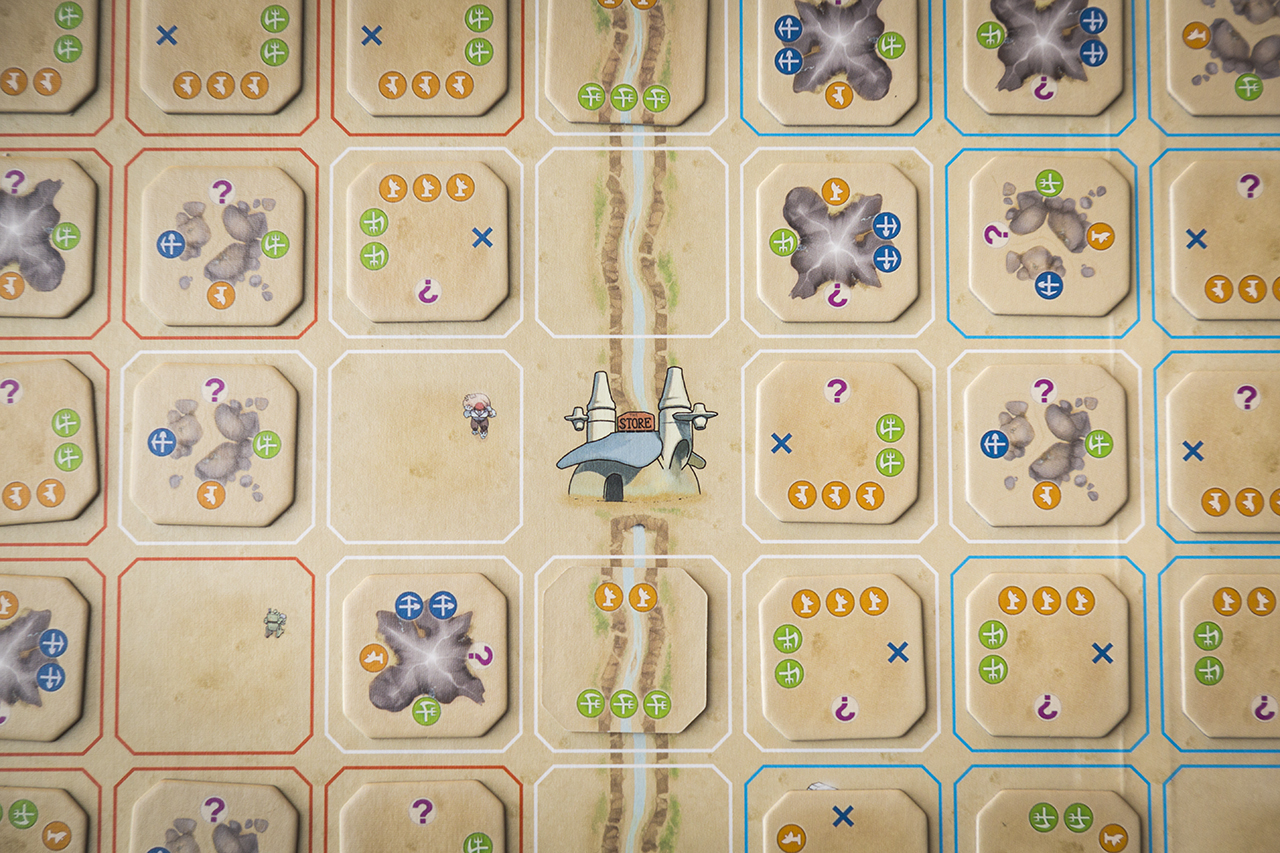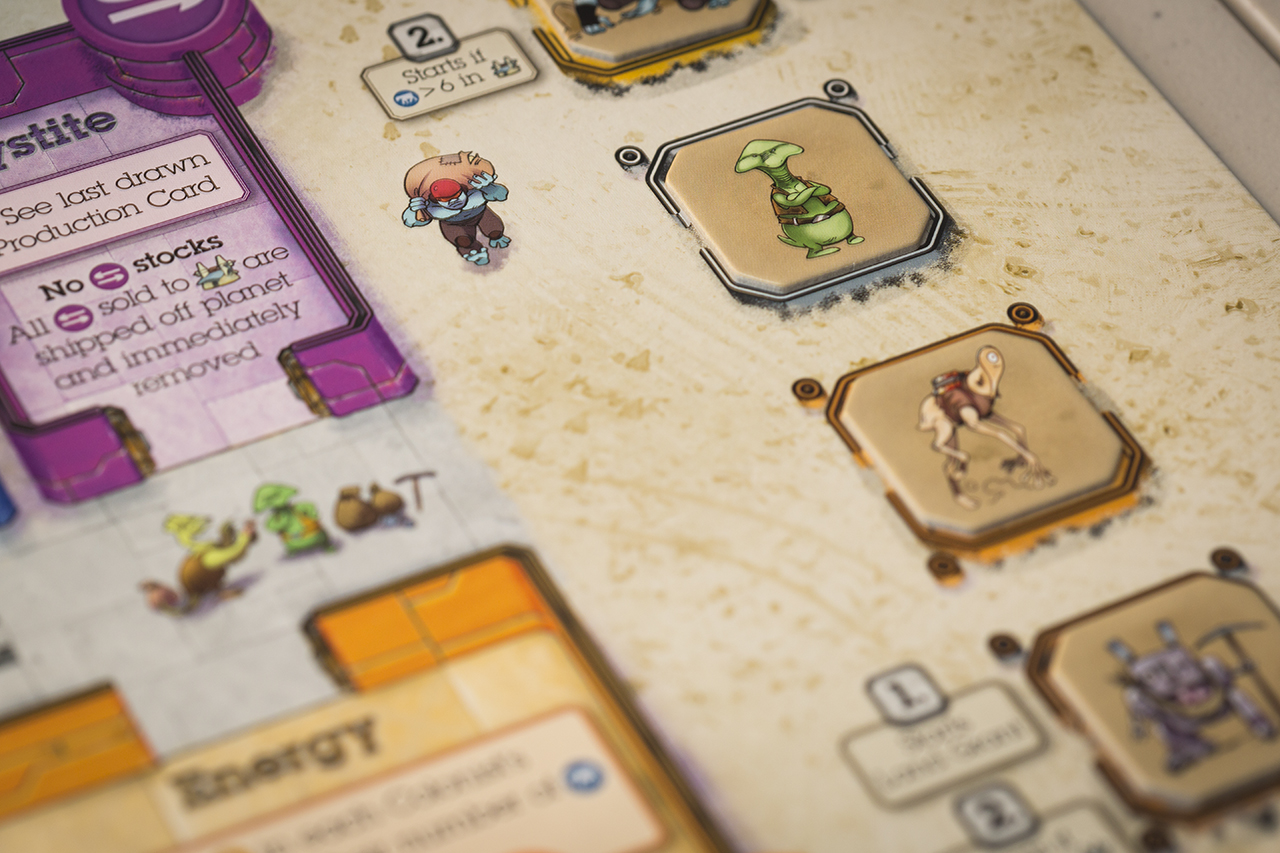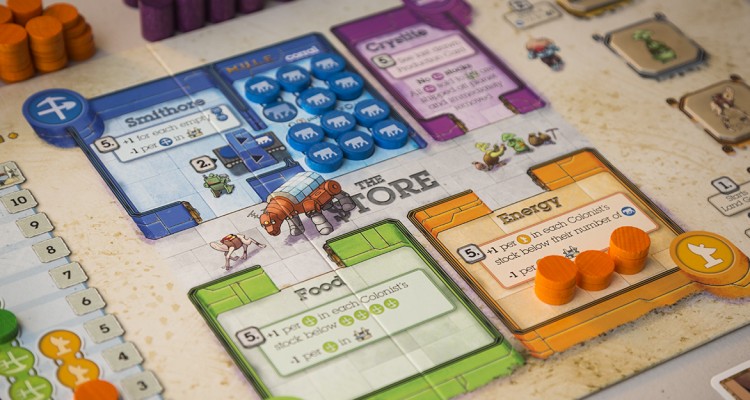M.U.L.E. is a competitive economic game for three to four colonists, based off of the old Atari game of the same name. In the transformation from console to board game, many elements were faithfully kept, some of which made the transition across formats better than others. As colonists and prospectors on the frontier world of Irata (catchy, huh?), your job is to claim, assay, and exploit the natural resources of the planet in order to turn the most profit. A shared colony store provides a marketplace for your goods such as Food, Energy, and Smithore, which is in turn used to create the eponymous M.U.L.E.s (Multiple Use Labor Elements) that are outfitted to harvest these resources in the first place. Supply and demand drive the availability and prices for these three goods, while a fourth, Crystite, is shipped offworld and the market price is subject to the vagaries of outside events. Speaking of outside events, quite a few random happenings are built into the base game, so be prepared to take setbacks and chance in stride.
Colony Charter
One of the first things you’ll notice after even a casual perusal through the rulebook, is that M.U.L.E. seems almost to be designed as a modular game; for every rule and mechanic there is also an option or perhaps a ‘designer recommended’ variant that lets you tweak it to your liking. There are two main methods of play, though, offering you a choice between the even-handed Beginner’s mode, or the slightly asymmetric and more involved Tournament mode. While you may wish to play an initial game on the lower level, spicing things up with the optional Tournament rules is highly recommended, and is the version of the game this review will cover.

To begin, each player receives a Colony board, featuring a map containing three coloured zones upon which they’ll be placing their claimed territory, and then chooses one of the eight races available in the game. Two of the races offer a positive / negative handicap, and some have no powers at all, so materials are provided to allow each race to be chosen twice. The main map board is then seeded with a random selection of land tiles of four terrain types: Rivers, Hills, Mountains, and Plains. Each terrain has a different selection of resources that they may produce, including a hidden value of Crystite. For this reason, the land tiles begin the game with the Public side face-up, keeping the Crystite value unknown until assayed. Players also begin the game with an initial stake of cash, enough Food and Energy for the first turn, a Land Auction card, and a Package from the Homeworld card that can be used to provide Energy / Food during a time of need. The game will progress across seven rounds, tracked by the special events from the Production deck, the first six of which will generally initiate a global modifier to one or more resources, or perhaps be a plan-thwarting Pirate Attack or Store Fire! The final turn occurs when the The Ship is Back! card is revealed, at the end of which all players must sell their remaining goods to the colony store and count their profits. Whoever has the most cash on hand at this point is the winner!
Point of Order
Each turn proceeds through a series of eight phases:
- Expansion – In reverse turn order, each player chooses one land tile from the main map board and claims it, adding it to their own colony board. Each tile belongs to a certain coloured area, and must be placed inside the matching zone on your colony. These different zones will affect the ease with which you can purchase and refit M.U.L.E.s on the various tiles. During the first turn, each player will have the opportunity take two plots of land for free.
- Development – During this phase, there are three rounds in which players may spend Food in order to take actions such as purchasing a M.U.L.E. from the colony store, assaying land tiles, refitting what resources a M.U.L.E. produces, gambling, or even hunting the elusive Wampus!
- Usage and Spoilage – It costs Energy to keep your M.U.L.E.s operational, so one Energy must be spent per M.U.L.E. that you own, with any shortfall causing an equal number of M.U.L.E. tokens to be flipped over to their inoperational side. Additionally, any stored resources over a certain number are subject to spoilage, and must be discarded; this keeps resources flowing through the market, and players from simply stockpiling production turn after turn, only to sell it as soon as the prices rise.
- Production – At the beginning of this phase, the next card in the Production Deck is flipped, and the effects applied. Maybe there’s a solar flare, and your energy-producing M.U.L.E.s are working overtime, or you get attacked by pests and lose all Food production for a round. Who knows? Next, every operational M.U.L.E. produces the chosen resources, and players add these from the supply to their stocks. The Tournament rules add in economies of scale, which makes terrain placement more important, and provides a bonus for adjacent M.U.L.E.s that are producing the same resource.
- Pricing – At this point, the prices in the colony store are adjusted due to the current supply in the store and the estimated demand from each player. For example, if players aren’t producing enough Energy to supply their M.U.L.E.s, then the price for Energy will trend higher, with the same for Food. Smithore is used to produce M.U.L.E.s in the store, so if everyone is purchasing them without selling any ore back to the colony, this particular commodity will almost immediately peg itself at the top of the track. On the other hand, since Crystite is an ‘offworld’ good, its price is only contingent on the value from the most recent Production Card. It’s likely you’ll see the market for certain goods rise and then crash several times throughout the game, as players (over)produce to meet perceived demand and take advantage of momentary high prices.
- Market – During this phase, players may buy and sell goods amongst themselves and to the store. Of course, the store wants to turn a profit, too, so keep in mind that they’ll accept goods from you for a markedly lower price then you can buy from them in turn.
- Ranking – Turn order is readjusted based on the amount of cash on hand; the wealthiest player is Rank 1, and so on.
- Personal Events – This inclusion in the game is the one that’s caused the most muttering. Intended as a catch-up mechanic of sorts, it’s designed so that a Lucky Event card is drawn and applied to the player in either 3rd or 4th place, while the 1st or 2nd-place player gets saddled with an Unlucky Event card. We felt that these events can often cause a larger swing than intended, and as one of the options in the rulebook is to do away with them, we eventually decided to do so.
If The Ship Is Back! card was drawn during this turn, the game ends after the completion of the Ranking phase. The player with the most cash on hand is declared the most successful colonist, and the winner!

Off-World Retirement, or Debtors Prison?
M.U.L.E. is a faithfully and well-produced reproduction from the early era of computer games; while this might seem an odd marriage of ideas, the basic economic engine is one that has survived well throughout the years, and as one of the first multiplayer-style games, it fits well into the current board-game paradigm. While the sheer number of variants and options available may seem overwhelming, it also allows you to pick and choose through a number of possibilities, many of which may smooth off a rough edge or two in your playing experience. The randomness of the Personal Event cards and even the Production deck may be offputting for some; an ill-timed Store Fire, which removes all of the in-stock goods from the colony store, can cause grave dissatisfaction when you were counting on the prices to tank due to an overabundance of supply.
Speaking of the store, the internal price-regulation mechanics are simple, but it may still take a play or two to learn how to gauge the change in costs from turn to turn. During our first game, we pegged the prices at the top of the charts for each and every resource after the first Pricing phase, and many stayed there for the rest of the game. Estimating the opportunity cost of producing what you need versus what will sell in the store is an important thing to consider. Overall, keeping the above caveats in mind, I would happily recommend M.U.L.E. to those that enjoy a light economic game, especially if they’re the sort to revel in the inherent nostalgia of the title.
[su_custom_gallery source=”media: 13232,13229,13228″ limit=”3″ link=”lightbox” target=”blank” width=”220″ height=”220″ title=”never”]
League Ruling
Matt
At first glance, M.U.L.E. is a tough game to peg, but you’ll quickly find that its quirky, tongue-in-cheek exterior acts as a thin veneer for the more straightforward economic inner-workings beneath. While you may play as a round, blue ball holding a golf club, or a creature most definitely derived from human male anatomy, your real focus moves past the silliness and focuses on the ups and downs of an ever-shifting commodities market. Getting a good handle on this basic exercise in supply-and-demand is the key to profiting big. What makes it tough, and more of a game to be played rather than a math problem to be solved, is the randomness created by your opponents and the event cards. While we eventually tossed the Lucky and Unlucky event cards because our group proved that we don’t play nice with others, there is still enough chaos created by independently minded people and the Crystite cards to make the buying and selling for profit a wild ride. And while the modularity in the rulebook seems excessive, it is nice to know that M.U.L.E. can be tailor fit to your group’s play style, with options ranging from complete card-flip gambling to more strict and sensible economics. Overall, I liked the game and found it to offer a different experience from many other games I’ve played. Anytime someone wants to break out the solar powered work horses and harvest some purple rocks, I’m game.








